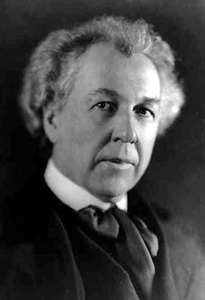 August 26, 1927
August 26, 1927
Madison, Wisc.
Frank Lloyd Wright was a favorite son of Los Angeles, where he threw off the Prairie mantle and began creating his kooky indigenous-flavored block houses (e.g., Storer, Millard, Ennis, Freeman) in contrast to the Spanish Colonial (or, say, Egyptoid Tudor Chateauxesque) prevalent in the Southland’s early 20s, before he said to hell with LA and lit out for his cursed home, Taliesin.
There was much architectural buzz about Mr. Wright in 1927, as he’d already designed a theater model for Aline Barnsdall, who announced in January that she’d build the structure as part of her eight-acre “city cultural center” gift to Los Angeles of her own FLW Hollyhock House and property.
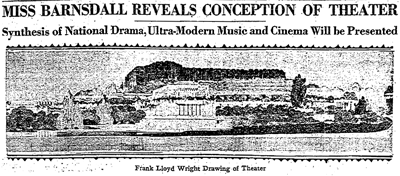
When the Smart People of to-day tour FLW’s block houses and consider his play of light over form, and gauge its relationship between the zig of Meiji woodblock prints and the zag of Walter Burley Griffin’s green thumb, they probably aren’t informed that ol’ FLW had a lurid past fit for any tabloid-worthy favorite son of Los Angeles.
For example, while married to Catherine Wright, he fell in love with another woman, one Mamah Borthwick. Catherine wouldn’t divorce him, so Wright abandoned her and the six kids and went galavanting around Europe with Mamah. On his return, Catherine still wouldn’t divorce him, so Wright brought scandal to Spring Green, Wisc. by shacking up with Mamah. This was sorted out in short order when one of his domestics decided to utilize a Wrightian architectural principal—one door for all purposes—which made it easy to axe-murder seven people trying to flee a Taliesin you’d just set on fire. And Mamah was one of those so axed.
Catherine finally divorced Frank in 1922 on charges of desertion, so he could marry his new love, a morphine addict named Miriam Noel. They married in 1923, separated in 1924; Wright began seeing Petrograd Ballet dancer Olgivanna Lazovich Milanov (thirty-three years his junior) in 1925 and was thereafter arrested in 1926 for violating the Mann (White-Slave Traffic) Act. Oh, and Taliesin burned again, though this time without anybody being hacked to bits.
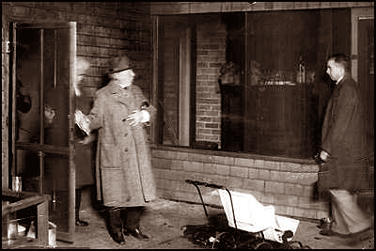
Frank getting popped by the feds, 1926
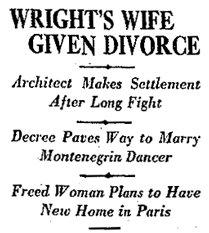 The lucky Wright-drama followers of 1927 were treated to tales of Frank and Miriam’s divorce. Today, Miriam was awarded $6,000 ($66,179 USD2006) immediately, $30,000 (330,889) in trust, and $250 (2,757) a month for life. The cash settlement and Wright’s promise that he "would lead a moral life" preceded the court decree.
The lucky Wright-drama followers of 1927 were treated to tales of Frank and Miriam’s divorce. Today, Miriam was awarded $6,000 ($66,179 USD2006) immediately, $30,000 (330,889) in trust, and $250 (2,757) a month for life. The cash settlement and Wright’s promise that he "would lead a moral life" preceded the court decree.
With a cushy settlement like that, you’d think that’s the last we hear of Miss Miriam. You’d be wrong. She spends the next few years loudly proclaiming Wright’s brutality and repellant morals, with much effort expended in Washington attempting to get Olga deported. In a typical Miriam moment, July 14, 1928, she is arrested on a charge of malicious mischief after breaking 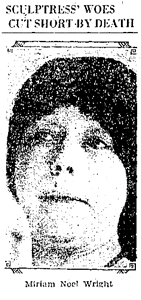 into FLW’s rented La Jolla home while he’s up in Los Angeles: “So thorough was the wrecking that the colored maid in charge of the house in Wright’s absence collapsed from the shock and was taken to the Scripps Memorial Hospital. ‘About fifteen minutes more and I would have leveled the place,’ Mrs. Wright is said to have told police when arrested…damage to the La Jolla home is estimated at about $1000…Mrs. Wright smiling pleaded guilty and following the court action, swore out complaints against her husband and Olga Hinzenberg, also known as Olga Milanoff, charging them with being lewd and dissolute persons.”
into FLW’s rented La Jolla home while he’s up in Los Angeles: “So thorough was the wrecking that the colored maid in charge of the house in Wright’s absence collapsed from the shock and was taken to the Scripps Memorial Hospital. ‘About fifteen minutes more and I would have leveled the place,’ Mrs. Wright is said to have told police when arrested…damage to the La Jolla home is estimated at about $1000…Mrs. Wright smiling pleaded guilty and following the court action, swore out complaints against her husband and Olga Hinzenberg, also known as Olga Milanoff, charging them with being lewd and dissolute persons.”
Miriam finally expires in 1930.
We’ll keep you posted on all breaking FLW news.
I’d keep an eye on that Schindler character if I were you.


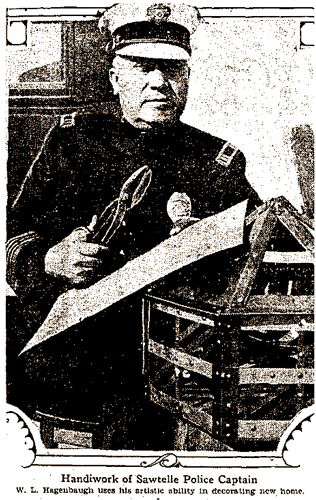 December 16, 1927
December 16, 1927 December 8, 1927
December 8, 1927 On a related note—here in the future—I like my palm tree. A lot. And who can blame me? So when I looked out my window and saw someone chainsawing up the palm in front of my home, I was close to grabbing something a lot stronger than a can of seasoning. (Never mind that it wasn’t really my palm—but on an embankment in front of my house—I loved my palm, dammit.) When the overscale condo development went up across the street from me, they stretched high-tension wires across to it. And then the DWP decided that the decades-old
On a related note—here in the future—I like my palm tree. A lot. And who can blame me? So when I looked out my window and saw someone chainsawing up the palm in front of my home, I was close to grabbing something a lot stronger than a can of seasoning. (Never mind that it wasn’t really my palm—but on an embankment in front of my house—I loved my palm, dammit.) When the overscale condo development went up across the street from me, they stretched high-tension wires across to it. And then the DWP decided that the decades-old 

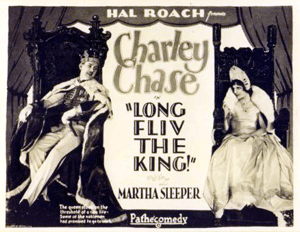 Chase is today best known for his work in promoting the exclamation-mark’d picture. Long before 1947, the year which saw two noir exclamation-mark’d masterpieces—Railroaded! and Boomerang!—and long before little girls screamed Them! and everyone shouted Oklahoma! and then we all yelled Faster, Pussycat! Kill! Kill!, Chase starred in Nurse to You!, Okay Toots!, You Said a Hatful!, What a Bozo!, Skip the Maloo!, and of course ¡Huye, Faldas!, to name but a few. He also asked the cinematic questions Are Brunettes Safe? and Is Everybody Happy? and Isn’t Life Terrible? and What Price Goofy? and Is Marriage the Bunk? and Should Husbands Be Watched? and Why Go Home? and while these aren’t exactly What Ever Happened to Baby Jane? or Who’s Afraid of Virginia Woolf? (or What’s the Matter With Helen? or Who Ever Slew Auntie Roo? for that matter) they sure beat the stuffing out of Where’s Poppa? and What’s So Bad About Feeling Good?
Chase is today best known for his work in promoting the exclamation-mark’d picture. Long before 1947, the year which saw two noir exclamation-mark’d masterpieces—Railroaded! and Boomerang!—and long before little girls screamed Them! and everyone shouted Oklahoma! and then we all yelled Faster, Pussycat! Kill! Kill!, Chase starred in Nurse to You!, Okay Toots!, You Said a Hatful!, What a Bozo!, Skip the Maloo!, and of course ¡Huye, Faldas!, to name but a few. He also asked the cinematic questions Are Brunettes Safe? and Is Everybody Happy? and Isn’t Life Terrible? and What Price Goofy? and Is Marriage the Bunk? and Should Husbands Be Watched? and Why Go Home? and while these aren’t exactly What Ever Happened to Baby Jane? or Who’s Afraid of Virginia Woolf? (or What’s the Matter With Helen? or Who Ever Slew Auntie Roo? for that matter) they sure beat the stuffing out of Where’s Poppa? and What’s So Bad About Feeling Good? 

 Pajamarino! Everybody loves pajamarino! Everybody, except, perhaps, Mr. Charles Chaplin.
Pajamarino! Everybody loves pajamarino! Everybody, except, perhaps, Mr. Charles Chaplin. Which is all fine and good, yet again, Mr. Chaplin would disagree, in that he showed up for work this morning ready to get to work on his new picture
Which is all fine and good, yet again, Mr. Chaplin would disagree, in that he showed up for work this morning ready to get to work on his new picture 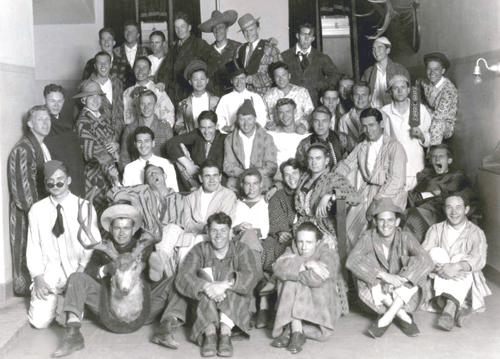



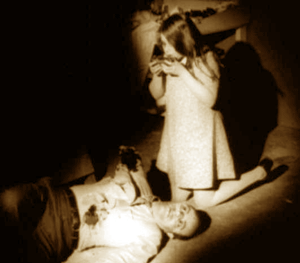

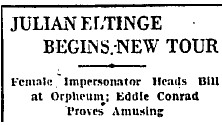 Famed vaudeville cross-dressing act Julian Eltinge performed today at the Orpheum, though the Times reported him to be "a trifle too old and portly to exactly suggest the flapper — his impersonation is limited to the more matronly of the species." Eltinge was approximately 46 (reported birthdates vary), and had been doing female impersonations in his act for over 35 years.
Famed vaudeville cross-dressing act Julian Eltinge performed today at the Orpheum, though the Times reported him to be "a trifle too old and portly to exactly suggest the flapper — his impersonation is limited to the more matronly of the species." Eltinge was approximately 46 (reported birthdates vary), and had been doing female impersonations in his act for over 35 years.
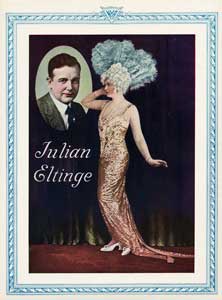 The Fascinating Widow, a musical comedy where he played both male and female roles, the latter of which would become his signature role. Eltinge was a hit, marketing his own line of magazines featuring beauty tips, as well as a line of cosmetics. Ads for his cold cream read, "See what the Julian Eltinge cold cream does for a man. Imagine what it will do for a woman."
The Fascinating Widow, a musical comedy where he played both male and female roles, the latter of which would become his signature role. Eltinge was a hit, marketing his own line of magazines featuring beauty tips, as well as a line of cosmetics. Ads for his cold cream read, "See what the Julian Eltinge cold cream does for a man. Imagine what it will do for a woman."



 August 26, 1927
August 26, 1927

 The lucky Wright-drama followers of 1927 were treated to tales of Frank and Miriam’s divorce. Today, Miriam was awarded $6,000 ($66,179 USD2006) immediately, $30,000 (330,889) in trust, and $250 (2,757) a month for life. The cash settlement and Wright’s promise that he "would lead a moral life" preceded the court decree.
The lucky Wright-drama followers of 1927 were treated to tales of Frank and Miriam’s divorce. Today, Miriam was awarded $6,000 ($66,179 USD2006) immediately, $30,000 (330,889) in trust, and $250 (2,757) a month for life. The cash settlement and Wright’s promise that he "would lead a moral life" preceded the court decree. into FLW’s rented La Jolla home while he’s up in Los Angeles: “So thorough was the wrecking that the colored maid in charge of the house in Wright’s absence collapsed from the shock and was taken to the Scripps Memorial Hospital. ‘About fifteen minutes more and I would have leveled the place,’ Mrs. Wright is said to have told police when arrested…damage to the La Jolla home is estimated at about $1000…Mrs. Wright smiling pleaded guilty and following the court action, swore out complaints against her husband and Olga Hinzenberg, also known as Olga Milanoff, charging them with being lewd and dissolute persons.”
into FLW’s rented La Jolla home while he’s up in Los Angeles: “So thorough was the wrecking that the colored maid in charge of the house in Wright’s absence collapsed from the shock and was taken to the Scripps Memorial Hospital. ‘About fifteen minutes more and I would have leveled the place,’ Mrs. Wright is said to have told police when arrested…damage to the La Jolla home is estimated at about $1000…Mrs. Wright smiling pleaded guilty and following the court action, swore out complaints against her husband and Olga Hinzenberg, also known as Olga Milanoff, charging them with being lewd and dissolute persons.”